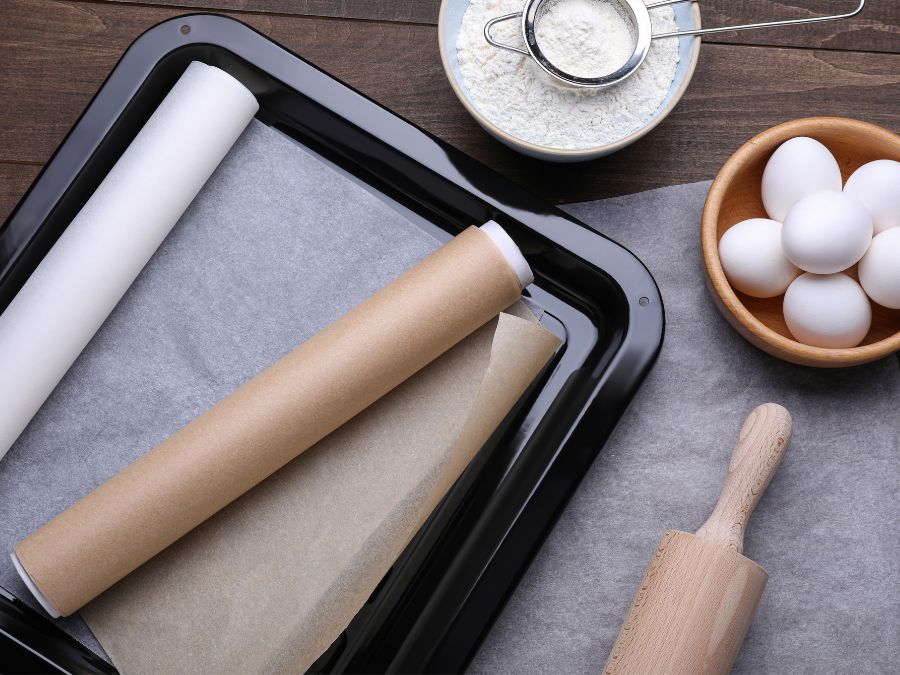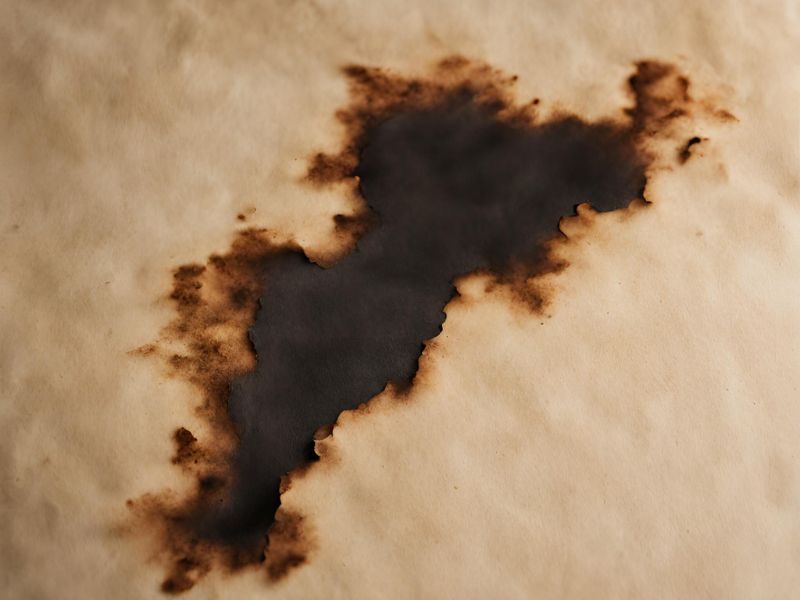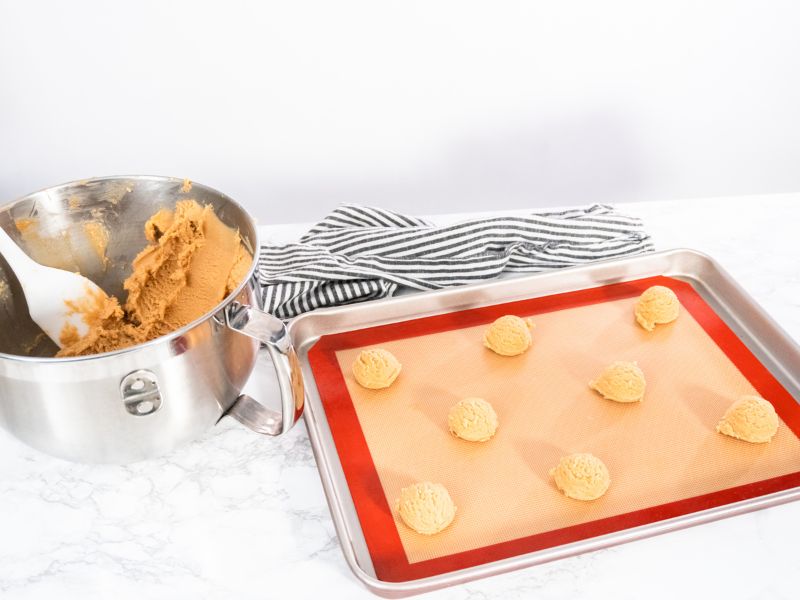Parchment paper is a handy tool that every baker should have in their kitchen. It has a silicone coating, preventing your baked goods from sticking. Parchment paper allows for easy transfer of items from the pan to the cooling rack. It also saves you time cleaning up pans after baking. But can you reuse parchment paper when whipping up several batches of cookies?
Affiliate Disclosure: Some of the links below are affiliate links, meaning at NO additional cost to you, I may earn a small commission if you click through and make a purchase. See full disclosure
- Can You Reuse Parchment Paper
- What is Parchment Paper?
- Regular Parchment Paper vs. Unbleached Parchment Paper
- The Benefits of Reusing Parchment Paper
- Possible Risks of Reusing Parchment Paper
- Tips for Safely Reusing Parchment Paper
- When It’s Time to Toss Out Reused Parchment
- Alternatives to Reusing Parchment Paper
- Final Thoughts
- Frequently Asked Questions
Can You Reuse Parchment Paper
Parchment paper can be safely reused in most baking situations. It is designed to withstand high heat and repeated baking when stored properly between uses. This cuts down on waste and expenses. With just a little care, the same parchment sheet can be reused many times over.
However, there are some exceptions. Parchment paper that has burned, torn, touched raw meat, or been exposed to moisture should be discarded. Reusing parchment repeatedly at temperatures over 420°F will cause faster breakdown. As long as you avoid these situations, your parchment paper should be fine for multiple bakes.
As an Amazon Affiliate, I may earn a commission from qualifying purchases.
What is Parchment Paper?
Parchment paper, often called bakery paper, is made of thick paper that is coated with silicone. The silicone coating prevents your baked goods from sticking, therefore allowing them to lift off the pan easily. It also creates a moisture barrier, keeping your baked goods from drying out. Eliminates the need to grease your pans. And clean-up is a breeze. Win-win.
It is NOT the same as waxed paper, which cannot tolerate high baking temperatures. Parchment paper works for most baking purposes, as long as temperatures do not go above 420°F.
Regular Parchment Paper vs. Unbleached Parchment Paper

When it comes to parchment paper, bakers have two main options – regular bleached parchment or unbleached parchment. While both provide ideal nonstick surfaces for baking, there are some key differences between the two.
Regular Parchment Paper
- Made from bleached white paper treated with silicone
- Has a bright, snowy white appearance
- Provides a nonstick surface for baking
- Withstands temperatures up to 420°F
- Has a smooth, thin, and pliable texture
- The most widely available and known form of parchment
Unbleached Parchment Paper
- Made from unbleached natural kraft paper
- Has a light brown color since no bleaching is used
- Also provides nonstick properties for baking
- Withstands high heat up to 420°F
- Tends to be a bit thicker and stiffer than regular parchment
- Considered more eco-friendly than bleached parchment
- Provides a rustic, crafts-style appearance
- Becomes more pliable when exposed to moisture
- A good option for bakers wanting a greener choice
The Benefits of Reusing Parchment Paper
Reusing parchment paper offers some excellent advantages:
- it’s great for the environment by reducing paper waste
- You’ll save money by getting more mileage out of each parchment paper roll. Parchment sheets aren’t cheap, so reusing them allows you to stretch your dollars.
- It’s super convenient when you’re baking large quantities or multiple batches of cookies. You can simply slide the liners right back into the oven.
Possible Risks of Reusing Parchment Paper
However, there are a few possible risks to be aware of when reusing parchment paper:
Cookies Sticking
Repeated high heat exposure can cause parchment paper to slowly lose its nonstick abilities. Plus, any moisture from the first batch of cookies can reduce the nonstick performance for the next batch placed on the same sheet.
Tiny tears in the parchment that develop after the first use will also make it easier for later batches of dough to stick. The holes provide crevices for the dough to grip onto.
Food Safety Concerns
If not cleaned properly between uses, bacteria can grow on used parchment sheets. Any oil, crumbs, or traces of raw dough left over from the prior bake can be transferred to the next batch of cookies.
Changes in Performance
Once heated and reused multiple times, parchment paper can begin to curl at the edges and corners. It also becomes more prone to excessive tearing, especially when worked with while still warm.
Tips for Safely Reusing Parchment Paper
| 🧁 Pro Tips for Safely Reusing Parchment 🧁 |
|---|
| 👍 Let cool fully before storage |
| 🌡️ Avoid excessive moisture, heat, sunlight |
| ✂️ Cut into smaller pieces to maximize uses |
| 🔎 Check for tiny tears before reusing |
| 🗑️ Toss at first sign of grease stains or brittleness |
| Brought to You by wearebaking.com |
Let it Cool Completely
It’s important to let the parchment paper cool fully before placing another batch of cookie dough on it. Warm parchment is weaker and prone to tearing. Place the sheets on a cooling rack until they are ready to reuse.
Clean Thoroughly Between Batches
Before reusing parchment, be sure to wipe it down thoroughly with paper towels to remove any oil or crumbs left behind. Wash the parchment sheets often with warm, soapy water before letting them fully dry.
Avoid Very Moist Doughs
Reusing parchment works best with somewhat stiffer and dryer doughs like shortbread. Some sugar cookie recipes may be too moist and sticky.
Rotate Baking Sheets and Racks
For the best results, rotate your baking sheets front to back and switch which racks they use. This helps prevent hot spots that can lead to excessive browning or burning on reused parchment paper
Watch for Damage
Inspect the parchment paper closely for small tears or holes after the first use. Discard the sheets at the first sign of the paper breaking down to prevent the dough from sticking.
Handle Gently
When reusing parchment, don’t aggressively scrub the surface. Gently lift warm cookies off the paper to avoid causing tears. Handle the paper carefully when hot.
Store Properly
After baking and cooling, keep reused parchment sheets in a sealed bag or container until the next use. Improper storage can lead to moisture exposure and premature deterioration.
When It’s Time to Toss Out Reused Parchment


As much as we want to get the most out of our parchment paper, there eventually comes a time when it’s best to say goodbye. Here are the signs that indicate your reused parchment has reached the end of its lifespan:
- Darkened, browned areas on the paper
- Tiny tears and holes all over the surface
- Cookies beginning to stick to the parchment paper
- Loss of all non-stick properties, even after cleaning
- Strong baked-in odors that transfer to other foods
At the first sign, it’s best to get rid of overused parchment sheets and replace them with fresh ones.
Alternatives to Reusing Parchment Paper

If reusing parchment paper still makes you wary or you want options for baking very sticky, moist doughs like sugar cookies, consider these alternatives:
- Invest in reusable silicone baking mats. These are naturally non-stick and more durable over many uses.
- Line pans with aluminum foil coated lightly in nonstick spray instead of parchment. Foil is better for very moist batters.
- Use an inverted baking sheet to cover the bottom of your pan rather than parchment.
Final Thoughts

Reusing parchment paper when baking multiple batches of cookies can be safe and effective when done properly. Here are the key tips to remember:
- Let the parchment paper cool fully before reusing it to prevent tearing.
- Clean gently between uses and watch for small holes.
- Avoid reusing parchment paper with very wet doughs prone to sticking.
- Rotate baking sheets and racks to prevent hot spots.
- Discard at the first sign of excessive browning, staining, or tearing.
With some care and caution, reusing parchment is an easy way to reduce waste and save money in your cookie-baking process. Follow these guidelines, and you’ll have no more sticky situations with reused parchment!
Do you reuse your parchment paper? Please leave me a comment below.
And As Always
Keep On Baking
Taianne
Share The Love
Frequently Asked Questions
Beyond the basics we’ve covered, you may be wondering about some other common concerns when it comes to reusing parchment paper. Let’s explore a few of the top additional questions people have.
How many times can you reuse parchment paper?
Parchment paper can generally be reused 5-10 times with proper storage and handling. Watch for deterioration signs like excessive grease, brittleness, and tearing. When those appear, it’s time to discard and replace the parchment.
Is parchment paper safer than aluminum foil?
Yes, parchment is considered safer than foil for baking. At high heat, aluminum foil can leach metal into foods. Parchment provides a non-stick barrier without this risk. Foil is also more likely to react with acidic ingredients.
Which is safer, parchment paper or wax paper?
Parchment paper is safer for baking. Wax paper can melt at high oven temperatures. Only parchment is designed for heat exposure up to 420°F.

I’m Taianne, the owner and operator behind We Are Baking. Baking my first cake at age 11 hooked me on creating sweet treats. Though my interest faded during childhood, it was rekindled when I married my apple pie-loving husband. I love trying new recipes, tweaking classics, and helping others learn the science and art of baking. I started We Are Baking to share tips, tricks, and favorite recipes I’ve discovered over the years. When not in the kitchen, I enjoy spending time with family and friends. My goal is to inspire others to embrace their creativity through baking. Feel free to contact me with any questions!
Taianne@wearebaking.com

